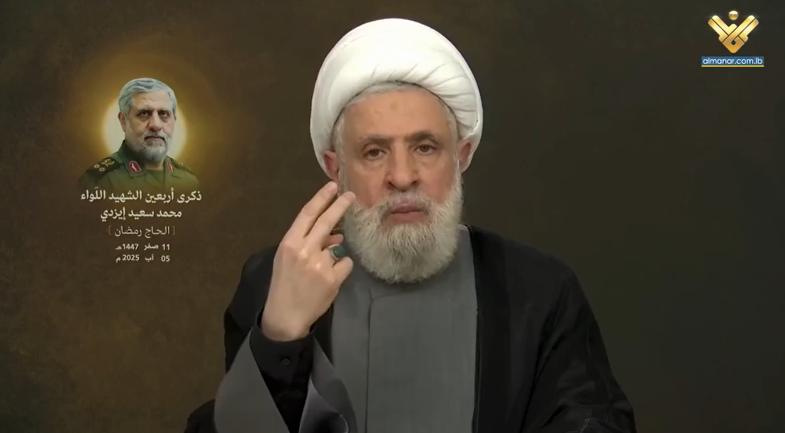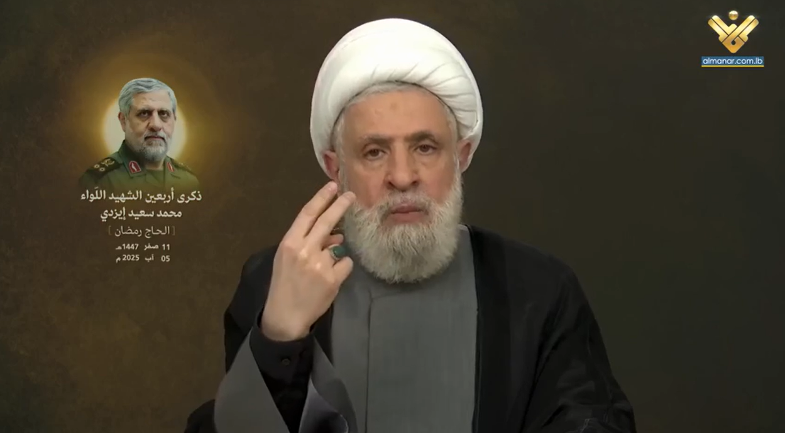 Na’im Qassem delivers a speech (al-Manar, August 5, 2025)
Na’im Qassem delivers a speech (al-Manar, August 5, 2025)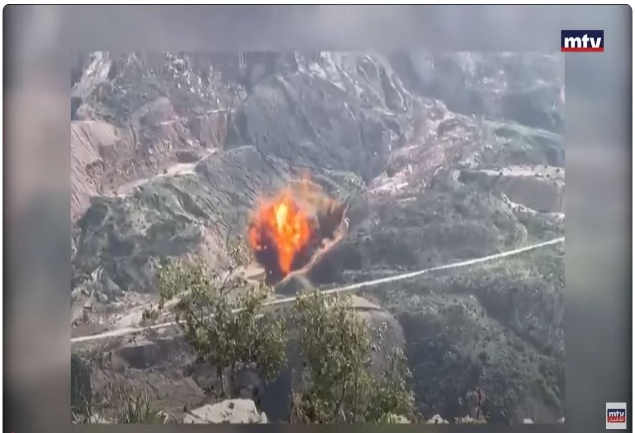 The scene of the explosion in Wadi Zibqin (MTV Lebanon, August 9, 2025)
The scene of the explosion in Wadi Zibqin (MTV Lebanon, August 9, 2025)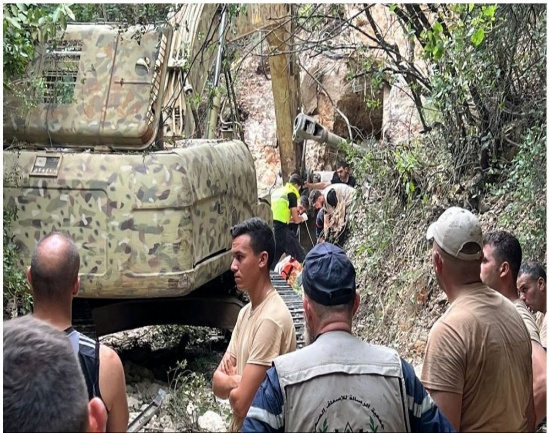 The scene of the explosion in Wadi Zibqin (MTV Lebanon, August 9, 2025)
The scene of the explosion in Wadi Zibqin (MTV Lebanon, August 9, 2025)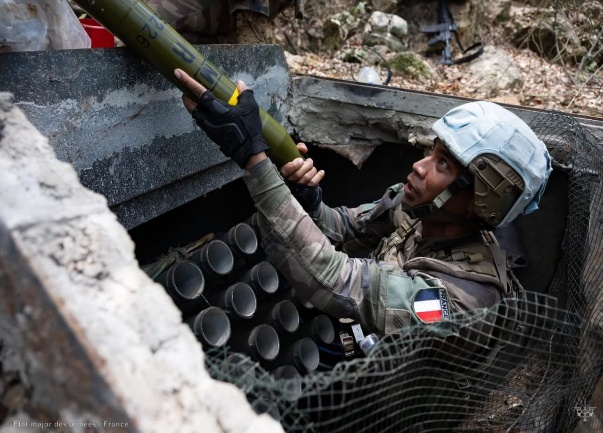 French battalion soldiers with the weapons found in the tunnels (French army X account, August 7, 2025)
French battalion soldiers with the weapons found in the tunnels (French army X account, August 7, 2025)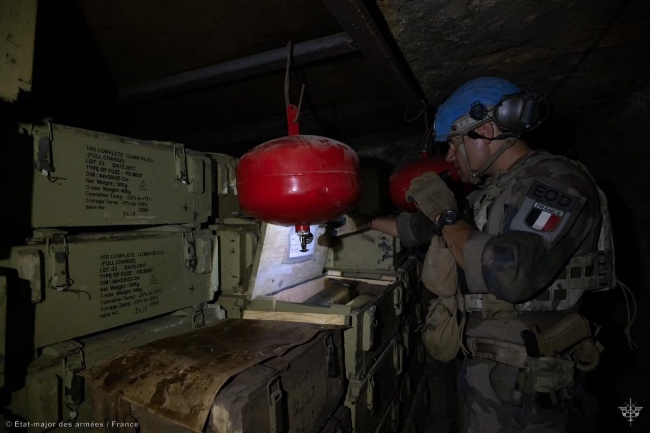 French battalion soldiers with the weapons found in the tunnels (French army X account, August 7, 2025)
French battalion soldiers with the weapons found in the tunnels (French army X account, August 7, 2025)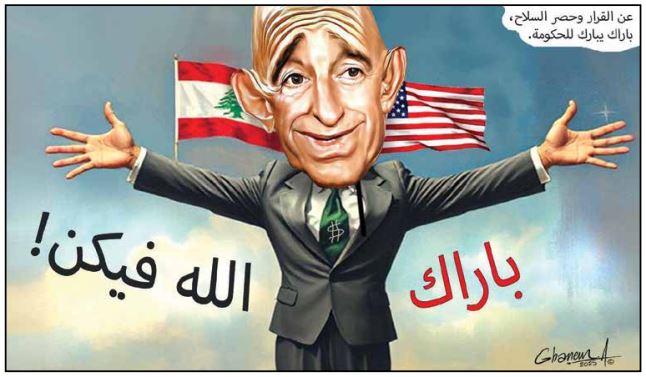 The American envoy, Thomas Barrack, congratulates the Lebanese government on its decision on disarmament (al-Joumhouria, August 8, 2025)Overview[1]
The American envoy, Thomas Barrack, congratulates the Lebanese government on its decision on disarmament (al-Joumhouria, August 8, 2025)Overview[1]
IDF forces attacked Hezbollah infrastructure and eliminated operatives of the organization as part of its continued activity against Hezbollah’s presence in south Lebanon, in violation of the understandings of the ceasefire agreement, and against the organization’s efforts to renew its military capabilities and restore its arsenal. Facilities in south Lebanon for storing engineering equipment for the restoration of capabilities were attacked and three Hezbollah operatives were eliminated, as was a senior terrorist operative from the Popular Front for the Liberation of Palestine.
Hezbollah secretary general Na’im Qassem reported that the organization had lost about 5,000 operatives in the campaign against Israel before the November 2024 ceasefire. In his assessment, Israel would not launch a new large-scale operation in Lebanon since the response would be missile fire into its territory.
Six Lebanese army soldiers were killed in an explosion in a tunnel used for storing Hezbollah weapons near Tyre. A UNIFIL force uncovered a tunnel network with weapons in south Lebanon.
The Lebanese government instructed the army to prepare a plan to disarm and dismantle all armed militias, including Hezbollah, by the end of the current year, and approved the principles of the document received from American special envoy Thomas Barrack. Hezbollah stated that it would ignore the government’s decisions and warned that no one would be able to disarm the “resistance.”
According to reports, Hezbollah’s public health organization suspended hospitalization payments for the families of Hezbollah operatives, a consequence of its economic crisis.
The Ceasefire
The IDF
The IDF continued to operate against Hezbollah targets located in south Lebanon in violation of the ceasefire agreement of November 27, 2024, which prohibited the organization’s presence south of the Litani River, and against Hezbollah’s efforts to renew its military capabilities and restore its arsenal. The IDF attacked weapons depots, rocket and missile launchers, and storage sites for engineering equipment used to reconstruct the organization’s military facilities in south Lebanon. Three Hezbollah terrorist operatives were eliminated, including one who directed terrorist squads in Syria to fire rockets at the Golan Heights. In an attack in the Beqa’a Valley, the head of the military-security department of the Popular Front for the Liberation of Palestine in Syria was eliminated (IDF spokesperson, August 5–11, 2025). The Lebanese ministry of health announced 11 killed and 14 wounded in the Israeli attacks (al-Nashra, August 5–11, 2025).
Hezbollah
Hezbollah secretary general Na’im Qassem said in reply to the government meeting on disarming Hezbollah, that in his assessment Israel did not want to initiate a large-scale attack against Lebanon, because in such a case the “resistance,”[2] the army, and “the people” would defend Lebanon and missiles would fall inside the “Zionist entity.” According to Qassem, if that happened the security that Israel had relied upon for eight months would vanish in an hour. Qassem said that during the last campaign against Israel, before the ceasefire at the end of November 2024, about 5,000 Hezbollah operatives had been killed and 13,000 wounded. He claimed that Hezbollah had fulfilled the ceasefire agreement “to the letter” with no violation towards the “enemy,” while the “enemy” had committed thousands of “violations.” He claimed that Israel regretted agreeing to the ceasefire because it allowed Hezbollah to retain its power, and that was the reason it was acting to disarm the organization (al-Mayadeen, August 5, 2025).

Na’im Qassem delivers a speech (al-Manar, August 5, 2025)
The Lebanese Army
The Lebanese army announced that six of its soldiers had been killed and others wounded following an explosion while a military unit was dismantling the contents of a weapons depot in Wadi Zibqin in the Tyre area. An investigation was reportedly opened to examine the circumstances of the incident (Lebanese army X account, August 9, 2025). “Military sources” reported that the explosion occurred in a tunnel where a artillery and shells were stored, and when the soldiers pulled the shell containers they blew up. An “explosives expert” said that one of the shells was connected to an explosive charge which caused the explosion, a method used by Hezbollah when it booby-traps positions it vacates to attack IDF soldiers when they inspect them. The investigation reportedly relied mainly on the testimony of one of the wounded soldiers who was part of the force that entered the tunnel (Nidaa al-Watan, August 11, 2025). Lebanese president Joseph Aoun said the soldiers’ deaths showed that the Lebanese army defended the homeland and guarded its borders. He added, “The blood of the dead will not be in vain, it will light the path of the struggle for a free Lebanon [sic]” (Lebanese presidency X account, August 9, 2025). Prime minister Nawaf Salam said that the incident showed the army was “the fortress of sovereignty” and defended the unity of the homeland and its legitimate institutions (al-Nashra, August 9, 2025).


The scene of the explosion in Wadi Zibqin (MTV Lebanon, August 9, 2025)
Acting commander of the Lebanese army, Major General Hassan Ouda, toured the South Litani headquarters at the Benoaa Bareqat Tyre camp and was briefed on the deployment of the operational units following “repeated attacks and violations” by Israel. He toured the 5th Infantry Brigade headquarters in al-Biadha and was briefed on its missions. He visited the engineering unit at the Chamoun camp in Nabatieh and offered condolences on the death of the soldiers in the tunnel explosion. Later, he visited one of the wounded soldiers in a hospital in Sidon (al-Nashra, August 10, 2025).
UNIFIL
The French army and UNIFIL spokesperson Andrea Tenenti reported that soldiers of UNIFIL’s French battalion had discovered an extensive network of fortified tunnels around Tayr Harfa, Zibqin, and al-Naqoura in south Lebanon. Tenenti said the tunnel network had hiding places, artillery, rocket launchers, shells, missiles, anti-tank mines, and various explosive charges (French army X account, August 7, 2025).


French battalion soldiers with the weapons found in the tunnels
(French army X account, August 7, 2025)
The Lebanese Government Decision to Disarm Hezbollah[3]
On August 5, 2025, the Lebanese government instructed the army to prepare a plan to disarm and dismantle all armed militias, including Hezbollah, by the end of the current year. Two days later, the government approved the principles of the document brought by the American special envoy, Thomas Barrack, which includes a timetable for disarmament. The ministers from the “Shi’ite duo” (Hezbollah and Amal) left in the middle of both meetings.
Hezbollah stated that it would ignore the government’s decisions and warned that no one could disarm the “resistance. Hezbollah said it was not prepared to discuss the issue of weapons before state authorities acted to end “Israeli aggression.”
Hezbollah and Amal were reportedly considering toppling the government in a parliamentary vote of no confidence. Ihab Hamadeh, a member of the Hezbollah faction in the Lebanese Parliament, said the government’s decision regarding weapons harmed the national agreement and warned that “the people will bring down the government and it will not last until the next elections.” He added that “the resistance will not give so much as a needle, and the attempt will fail” (NNA, August 2025).
Hezbollah supporters held rallies in the organization’s strongholds across the country, while the Hezbollah-affiliated media accused Aoun and Salam of acting in the service of the United States and Saudi Arabia.
According to a poll published by Hezbollah’s daily al-Akhbar, 58% of respondents rejected the idea of disarming the “resistance” without first formulating a national defense strategy, with 96% of Shi’ite respondents opposing disarmament, 50% of Sunnis, 46% of Druze, and 32% of Christians. The poll, conducted before the government meeting on disarmament, also found that 72% of respondents believed the Lebanese army did not have the capabilities to deal alone with “Israeli aggression” (al-Akhbar, August 11, 2025).[4]
Hezbollah’s political opponents welcomed the government’s decision to disarm Hezbollah, noting that it was a final decision with which the organization had to comply. They stressed that the weapons in Hezbollah’s hands had only damaged Lebanon.
According to reports, the Lebanese army is expected to begin disarming Hezbollah in a relatively isolated area between the Litani and the Awali Rivers to limit the presence of weapons in areas not subject to international supervision. The second stage will take place between Sidon and Beirut, and as the plan progresses, half of Lebanon’s territory will be cleared of weapons not in the possession of official security forces. The most significant challenge will be the third stage, which will focus on the Beqa’a Valley and north Lebanon, where Hezbollah has a significant military presence. That stage is supposed to include dismantling strategic weapons, such as anti-aircraft and anti-tank missiles, UAVs, and heavy weapons (Aram News, August 8, 2025).
“High-ranking diplomatic sources” revealed that intelligence agencies in friendly Arab and Western countries warned Lebanon’s political and security leadership that Iran had instructed Hezbollah to prepare operational plans to assassinate officials, government ministers, and political leaders who worked to promote the disarmament process. According to the “sources,” one objective is to carry out an assassination similar to the killing of former prime minister Rafik al-Hariri in 2005, in order to disorient Lebanon and throw it into a “dark tunnel” which would lead to the collapse of the current government and the loss of internal and international support. In that way Hezbollah hopes to postpone the issue of its disarmament for many years and to threaten anyone who tries to harm the organization’s weapons (Aram News, August 9, 2025).
In the assessment of a “senior Shi’ite source,” the government will hold further discussions on the American document, despite the opposition of the “Shi’ite duo” ministers, and therefore the conflict between the sides is expected to continue. The “source” stressed that the situation was particularly critical and that all sides were stuck not in a bottleneck but in a “narrow room” from which they would need a miracle to escape. He said “Shi’ite duo” was very suspicious and claimed that the government had harmed the core of state interests. He added that the ball was in the court of those who had made the decisions and the future path depended on “developments that might arise.” “Sources close to the Shi’ite duo” claimed that the government had effectively abolished the constitution by making illegitimate and unconstitutional decisions in the absence of its Shi’ite component, the result of the ministers’ departure from the meetings. A “political source” stressed that civil peace was a “red line” and he rejected all forms of violence, especially because “experience has shown that we have experience with the street and can be in the street and end up in streets that spin out of control” (al-Joumhouria, August 9, 2025).

The American envoy, Thomas Barrack, congratulates the Lebanese government on its decision on disarmament (al-Joumhouria, August 8, 2025)
Challenges for Hezbollah
According to reports, the Islamic Health Organization, a Hezbollah institution which provides medical services to Hezbollah operatives and to members of the Shi’ite community,[5] suspended the hospital coverage it provided to the families of Hezbollah members, a consequence the organization’s economic crisis. As a result, patients were asked to move to the al-Rassoul al-Azam Hospital in Beirut (Nidaa al-Watan, August 11, 2025).
The Reconstruction of Lebanon
A critical article claimed that the lack of a genuine political decision was keeping the reconstruction of Lebanon from developing, given the explicit or implicit rejection by Israel, the United States, and perhaps Arab states which were vetoing the reconstruction process. According to the article, although the government’s platform made reconstruction its top priority, the government had not taken serious action since the ceasefire, no committees had been established to assess the damage, and no comprehensive report had been prepared quantifying precisely the extent of the destruction and the true cost of reconstruction. It was further claimed that recent reconstruction began only after former minister Ali Hamia was appointed as an advisor to the president for reconstruction affairs, and began working to market the reconstruction portfolio abroad to friendly countries (al-Nashra, August 5, 2025).
Criticism was also published on Hezbollah’s al-Manar website, stating that since the establishment of the Lebanese government its agenda had revolved almost exclusively around “disarming the resistance.” Meanwhile, the issues of the economy, jobs and the environment had slipped to a secondary position or been marginalized even though they directly affected the lives of the Lebanese population. The article rejected the official position that disarmament was a condition for receiving international aid for reconstruction. It claimed that according to the World Bank, the overall cost of reconstruction amounted to about $11 billion, while the cost of housing ranged between $3 billion and $5 billion. In addition, the damage assessment committee of Hezbollah’s Jihad al-Bina Association estimated the initial cost of reconstruction of the Dahiyeh al-Janoubia in Beirut, south Lebanon, and the Beqa’a Valley at only $3 billion. Therefore, the article argued, improving the state’s tax collection could provide sufficient funding for reconstruction without needing external sources and without imposing political conditions which harmed national sovereignty (al-Manar website, August 9, 2025).
The Palestinians in Lebanon
Chairman of the Lebanese-Palestinian Dialogue Committee, Ramez Dimechkie, met in Beirut with a Hamas delegation headed by the movement’s representative in Lebanon, Ahmed Abd al-Hadi. They discussed the situation of Palestinian refugees in Lebanon and developments in the Palestinian territories. According to the report, they said the issue of the refugees had to be addressed from a comprehensive perspective ensuring Lebanese sovereignty and promoting stability and civil peace. Dimechkie also noted the importance of granting exclusivity over weapons to the state and the need to strengthen coordination between the Lebanese and Palestinian authorities (Lebanese News Agency, August 5, 2025).
[1] Click https://www.terrorism-info.org.il/en to subscribe and receive the ITIC’s daily updates as well as its other publications.
[2] Hezbollah and the Palestinian terrorist organizations operating in Lebanon.
[3] For further information, see the August 2025 ITIC report, “Lebanese Government Decides to Disarm Hezbollah – Positions of Power Actors.”
[4] The survey was conducted between July 27 and August 4, 2025, among 600 respondents (54% men and 46% women) selected randomly from all regions, sects, and age groups. The margin of error is 5%.
[5] For further information, see the July 2019 ITIC report, “The Islamic Health Organization: Hezbollah institution providing health services to Hezbollah operatives and the Shiite population in general as a means for gaining influence and creating a Shiite mini-state within Lebanon.“
Related Articles

